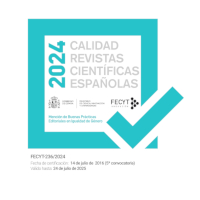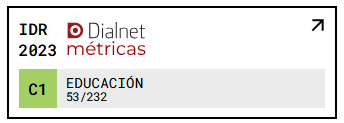Emotional intelligence and creativity in 1st and 2nd Primary students. Are there differences by gender?
DOI:
https://doi.org/10.18172/con.3530Keywords:
Emotional intelligence, creativity, gender, Elementary studentsAbstract
The objective of this research was to analyze the relationship between creativity and emotional intelligence. The method used in the research has been of a quantitative nature, based on the application of the Torrance Creative Thinking Test (figurative expression) and the emotional intelligence questionnaire EQ-i-YV for children and adolescents of Bar-On y Parker, a sample of 957 1st and 2nd grade students (6-8 years old). The results show how age and gender have an effect on creativity and emotional intelligence. In addition, 47.43% of the participants presented low levels of creativity, while 14.10% presented high levels in this construct. The correlations between creativity and emotional intelligence were low. When gender is taken into account, it is observed that while this relationship between the variables is low in the case of men (r=.06), in the case of women it is lower (r=.02). The presented model presented an optimal fit: χ2 (33) = 62.879 p <0.001; χ2 / df = 1.905; CFI = 0.96; NFI = 0.96; TLI = 0.95; RMSEA = 0.042, 95% CI (0.028 – 0.057). As a conclusion, to affirm that the data of the research show the need to work programs that work on creativity and emotional intelligence, that can provide emotional support and serve in the personal development of students from the first years of Primary.
Downloads
References
Ackerman, P. L. (2017). Adult intelligence: the construct and the criterion problem. Perspectives on Psychological Science, 12(6), 987-998. https://doi.org/10.1177/1745691617703437.
Alfaro, V., Bastias, J. y Salinas, F. J. (2016). Relación entre inteligencia emocional y notas de las áreas instrumentales en un grupo de tercero de Primaria. Revista Electrónica de Formación del Profesorado, 19(3), 149-155. https://doi.org/10.6018/reifop.19.3.267301.
Ato, M. y Vallejo, G. (2015). Diseños de investigación en Psicología. Madrid: Pirámide.
Bar-On, R. (2006). The Bar-On model of emotional-social intelligence (ESI). Psicothema, 18(1), 13-25.
Belmonte-Lillo, V. M. y Parodi, A. I. (2017). Creativity and adolescence: Differences according to gender, course and cognitive level. European Journal of Investigation in Health Psychology and Education, 7(3), 177-188.
Beghetto, R. A. y Kaufman, J.C. (2017). Four faces of creativity at school. En Nurturing creativity in the classroom (2nd. Ed.) (pp. 337-354). Cambridge: Cambridge University Press.
Boden, M. T. y Thompson, R. J. (2017). Meta-analysis of the association between emotional clarity and attention to emotions. Emotion Review, 9(1), 79-85. https://doi.org/10.1177/1754073915610640.
Candela, C., Barberá, E., Ramos, A. y Sarrió, M. (2002). Inteligencia emocional y la variable género. Revista Electrónica de Motivación y Emoción, 5(10).
Clapham, M. M. (1998). Structure of figural forms A and B of the Torrance Tests of Creative Thinking. Educational y Psychological Measurement, 58(2), 275-283.
Diamond, A. (2013). Executive functions. Annual Review of Psychology, 64, 135-168. https://doi.org/10.1016/annurev-psych-113011-143750.
Du, Y. N., Li, P. y Zhang, L. (2018). Linking job control to employee creativity: The roles of creativity efficacy and regulatory focus. Asian Journal of Social Psychology, 21(3), 187-197. https://doi.org/10.1111/ajsp.12219.
Fernández-Río, J. (2018). Creación de vídeos educativos en la formación docente: un estudio de caso. Revista Electrónica de Formación del Profesorado, 21(1), 115-127. https://doi.org/10.6018/reifop.21.1.293121.
Ferrando, M. (2006). Creatividad e Inteligencia Emocional. Un estudio empírico en alumnos con altas habilidades. Tesis Doctoral. Departamento de Personalidad, Evaluación y Tratamientos Psicológicos. Universidad de Murcia. Recuperado de https://digitum.um.es/xmlui/handle/10201/203.
Fischer, A. H., Kret, M. E. y Broekens, J. (2018). Gender differences in emotion perception and selfreported emotional intelligence: A test of the emotion sensitivity hypothesis. PLoS ONE, 13(1), e0190712. https://doi.org/10.1371/journal. pone.0190712.
Gardner, H. (1998). Inteligencias múltiples. La teoría en la práctica. Barcelona: Paidós.
Gartxia, L., Aritzeta, A., Bulluerka, N. y Barberá, E. (2012). Inteligencia emocional y género: más allá de las diferencias sexuales. Anales de Psicología, 28, 567-575. https://doi.org/10.6018/analesps.28.2.124111.
Goleman, D. (1996). Inteligencia emocional. Barcelona: Karós.
Guilford, J. P. (1950). Creativity. American Psychologist, 5(9), 444-454.
Ivcevic, Z., Brackett, M. A. y Mayer, J. D. (2007). Emotional intelligence and emotional creativity. Journal of Personality, 75(2), 199-236.
Jiménez, J. E., Artiles, C., Rodríguez, C. y García, E. (2007). Adaptación y baremación del test de pensamiento de Torrance: expresión figurada. Educación Primaria y Secundaria. Canarias: Gobierno de Canarias.
Leggett, N. (2017). Early childhood creativity: challenging educators in their role to intentionally develop creative thinking in children. Early Chilhood Education Journal, 45(2), 845-853. https://doi.org/10.1007/s10643-016-0836-4.
Martín-Bravo, C. (2006). Psicología para maestros dentro del E.E.E.S. Revista Interuniversitaria de Formación del Profesorado, 20(3), 151-182.
Mayer, J. D. y Salovey, P. (1997). What is the emotional intelligence? En Mayer, J. D. y Salovey, P. (Eds.). Emotional development and emotional intelligence. New York: Basic Book.
Naderi, H., Abdullah, R., Aizan, H., Sharir, J. y Kumar, V. (2010). Relationship between creativity and academic achievement: A study of gender differences. Journal of American Science, 6(1), 181-190.
Paños, J. (2016). Educación emprendedora y metodologías activas para su fomento. Revista Electrónica de Formación del Profesorado, 20(3), 33-48. https://doi.org/10.6018/reifop.20.3.272221.
Perera, H. N. y DiGiacomo, M. (2013). The relationship of trait emotional intelligence with academic performance: A meta-analytic review. Learning and Individual Differences, 28, 20-33. https://doi.org/10.1016/j.lindif.2013.08.002.
Prieto, M. D., López, O. y Ferrandiz, C. (2003). La creatividad en el contexto escolar. Madrid: Pirámide.
Prieto, M. D., López, O., Bermejo, M. R., Renzulli, J. y Castejón, J. L. (2002). Evaluación de un programa de desarrollo de la creatividad. Psicothema, 14(2), 410-414.
Rabari, J., Indoshi, F. y Omusonga, T. (2011). Differences in Divergent Thinking among Secondary School Physics Students. Journal of Emerging Trends in Educational Research and Policy Studies, 2(4), 216-227.
Ramy, M. R., Beydokhty, A. A. A. y Jamshidy, L. (2014). Correlation between Emotional Intelligence and Creativity Factors. International Research Journal of Management Sciences, 2(10), 301-304.
Salavera, C. y Usán, P. (2017). Repercusión de las estrategias de afrontamiento de estrés en la felicidad de los alumnos de Secundaria. Revista Electrónica de Formación del Profesorado, 20(3), 65-77. https://doi.org/10.6018/reifop.20.3.282601.
Salavera, C., Usán, P. y Jarie, L. (2017). Emotional intelligence and social skills on self-efficacy in Secondary Education students. Are there gender differences? Journal of Adolescence, 60, 39-46. https://doi.org/10.1016/j.adolescence.2017.07.009.
Salcenau, C. (2016). Emotional intelligence and creativity in school-aged children and preadolescents. Bulletin of the Transilvania University of Braşov, 9(58), 121-128.
Salovey, P. y Mayer, J. D. (1990). Emotional intelligence. Imagination, Cognition and Personality, 9, 185-211.
Seligman, M. E. y Csikszentmihalyi, M. (2000). Positive psychology. An introduction. The American Psychologist, 55(1), 5-14.
Silvia, P. J., Beaty, R. E., Nusbaum, E. C., Eddington, K. M., Levin-Aspenson, H. y Kwapil, T. R. (2014). Everyday creativity in daily life: An experience-sampling study of “little c” creativity. Psychology of Aesthetics, Creativity, and the Arts, 8, 183-188. https://doi.org/10.1037/a0035722.
Soroa, G., Gorostiaga, A., Aritzeta, A. y Balluerka, N. (2015). A shortened Spanish version of the Emotional Creativity Inventory (the ECI-S). Creativity Research Journal, 27(2), 232-239. https://doi.org/10.1080/10400419.2015.1030313.
Sternberg, R. J. (1986). Intelligence, wisdom and creativity. Educational Psychologist, 21(3), 175-190.
Sternberg, R. J. (1990). Más allá del cociente intelectual. Una teoría triárquica de la inteligencia humana. Bilbao: Desclée de Brouwer.
Sternberg, R. J. (1999). Handbook of creativity. New York. Cambridge University Press.
Sternberg, R. J. (2005). WICS: A Model of Positive Educational Leadership Comprising Wisdom, Intelligence, and Creativity Synthesized. Educational Psychology Review, 17(3), 191-262. https://doi.org/10.1007/s10648-005-5617-2.
Sternberg, R. J. (2015). Teaching for Creativity: The Sounds of Silence. Psychology of Aesthetics, Creativity, and the Arts, 9(2), 115-117.
Torrance, E.P. (1974). The Torrance test of creative thinking: Norms-Technical manual.
Villamizar, G. (2012). La creatividad desde la perspectiva de estudiantes universitarios. Revista Iberoamericana sobre Calidad, Eficacia y Cambio en Educación, 10(2), 212-237.
Downloads
Published
How to Cite
Issue
Section
License
The authors retain copyright of articles and authorize Contextos Educativos. Revista de Educación the first publication. They are free to share and redistribute the article without obtaining permission from the publisher as long as they give appropriate credit to the editor and the journal.
Self-archiving is allowed too. In fact, it is recommendable to deposit a PDF version of the paper in academic and/or institutional repositories.












